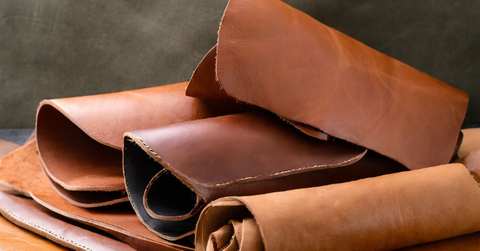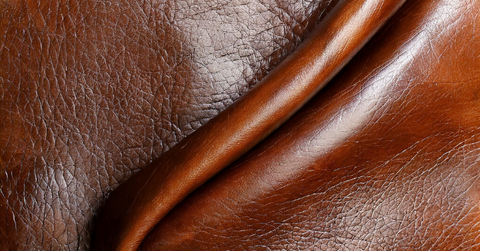Vegetable Tanned VS Chrome Tanned Leather: The Tale of Two Tanning Techniques

When diving into the intricate world of leather, one of the hottest debates is centered around Vegetable tanned VS Chrome tanned Leather. Each method has its unique characteristics, advantages, and devoted fan base. But for those new to the leather realm or simply curious about which method is superior, we're here to unpack the details of both and lay them bare (pun intended).
Comparison Table:
| Attributes | Vegetable Tanned Leather | Chrome Tanned Leather |
|---|---|---|
| Primary Agent Used | Plant tannins (e.g., oak, hemlock bark) | Chromium salts |
| Tanning Duration | Several weeks to months | Approximately a day |
| Texture | Firmer | Softer and more malleable |
| Color Variety | Earthy tones | Wide array of colors |
| Patina Development | Develops rich patina over time | Less significant patina development |
| Environmental Concerns | Lower impact | Use and disposal of chromium can be environmentally concerning |
| Cost | Generally higher due to prolonged tanning process | Typically more affordable |
| Scratch Resistance | More prone to scratches | More resistant to scratches |
| Country Production | Europe, North America | Global, especially Asia and South America |
| % of Production | Approximately 10% | Approximately 80% |
| Commonly Used For | Bags, belts, saddles, high-end footwear | Jackets, upholstery, everyday footwear, handbags |
Vegetable Tanned Leather: Nature's Own Palette
Imagine walking through a serene forest, your hands brushing against the rough bark of trees like oak, hemlock, and chestnut. Now, believe it or not, these very trees play a pivotal role in the process of vegetable tanning.

Vegetable tanning is the oldest form of leather tanning. It involves the use of tannins found in plant matter, primarily tree bark. The leather produced is known for its earthy hues and its ability to develop a rich patina over time. This means that with age and exposure, the leather's appearance becomes more unique and distinguished. That vintage leather satchel you've seen around in boutique stores? Chances are, it's vegetable-tanned.
However, it's not all roses. Vegetable tanning takes a long time, sometimes up to several months. This extensive process often translates to higher costs for the end product. Moreover, it tends to be less resistant to water, and yes, it can scratch relatively easily. But many enthusiasts embrace these 'imperfections' as an authentic testament to the leather's natural origin and journey.
Chrome Tanned Leather: The Modern Maverick
Switching gears, imagine a bustling tannery filled with barrels of blue-green solutions. That's the world of chrome tanning.

Introduced in the 19th century, chrome tanning employs the use of chromium salts and acids. This method is significantly faster than its vegetable counterpart, taking merely a day or so. The leather produced is soft, malleable, and available in a vast array of colors. That sleek, vibrant leather jacket in your closet? It's probably chrome-tanned.
While chrome tanning wins in speed and color variety, it does face criticism. There are environmental concerns related to the use and disposal of chromium. Additionally, while a well-maintained chrome-tanned leather product can last years, it doesn't quite develop the deep patina of vegetable-tanned leather.
Weighing the Pros and Cons
At the end of the day, neither method is definitively "better." It's more about individual preferences and intended use. If you're looking for a piece with a story, one that evolves with you, vegetable tanned might be your pick. But if you're after a fashionable item, available in myriad colors and soft to the touch, chrome tanned is the way to go.
FAQs:
How can you tell the difference between vegetable tanned and chrome tanned leather?
The most apparent differences lie in their appearance and texture. Vegetable-tanned leather jackets for men & women is firmer, can develop a patina, and usually comes in earthy tones. Chrome-tanned leather, on the other hand, is softer, more flexible, and available in a broad spectrum of colors.
Is vegetable tanned leather more expensive?
Generally, yes. The lengthy tanning process and the premium quality lambskin leather often mean higher prices for vegetable-tanned leather products.
Why is vegetable tanned leather so expensive?
It's mainly due to the prolonged tanning process, the quality of raw materials used, and the craftsmanship involved. Additionally, vegetable-tanned leather goods are often handcrafted, adding to their value.
Does vegetable tanned leather scratch easily?
Yes, it's more prone to scratches compared to chrome-tanned leather. However, many see these marks as a natural patina that adds character over time.
Is chrome tanned leather bad?
"Bad" is subjective. While chrome tanning is faster and offers more vibrant colors, it does raise environmental concerns due to the chemicals involved. From a durability perspective, it's relatively robust and long-lasting when cared for.
How long does chrome tan leather last?
With proper care, chrome-tanned leather can last for many years. Its longevity is comparable to vegetable-tanned leather, but it may not develop the same rich patina over time.